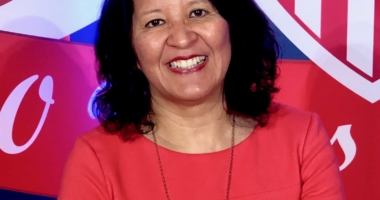Profiles in Education Equity: Qubilah Huddleston, P-12 Policy Lead for Ed Trust
Qubilah Huddleston is a P-12 policy lead, and she will help shape Ed Trust’s policy positions on equitable school funding. A native of Charlotte, North Carolina, Qubilah analyzes state and federal policy proposals and supports state partners and advocates in achieving more equitable state funding formulas for students of color and students from low-income backgrounds. I talked to her about her own background, her new role at Ed Trust, and what she sees for the future of school funding.
What led you to advocate for education equity?
It started from personal experience. I was bussed. I went to magnet schools; I went to Title I schools; and I didn’t have complete access to AP classes. A defining moment was when I was in high school and needed to be in an AP Biology class. My school didn’t offer many AP classes, and the school counselor was refusing to adjust the schedule so that I and a few other students could take the class. She was like, “We just can’t do that. We don’t have the resources.” She was very dismissive. We were like 17 or 18, standing up to our guidance counselor. Then, the principal walked in, we told her what was happening, and she said, “Change the schedule. They need to have access to this class.” Students shouldn’t have had to self-advocate, but we did, and it worked. I wish more of my peers had known that was an option.
Later, I tutored students in the out-of-school-time environment. I had a student who was like, “Miss Q, my teacher never explains it this way. My teacher never gives me enough time in the classroom.” I felt like we need to change things, like policies need to change, because many of those students had similar stories about having their needs dismissed. And I just tried to let them know that “It’s not you,” and “That isn’t fair,” and “You deserve more.” That’s why I’m so outspoken about the issues because those stories were just too frequent. I felt like these were injustices, so I pretty much made a beeline to education.
What brought you to Ed Trust?
Everything that Ed Trust is working to change in schools across the country are things that I’ve personally experienced. I want fewer kids of color and kids from low-income backgrounds to have to deal with what I did. It’s important to me that I use my skillset in a place that is on that same page. If you don’t have that lens, to me, you’re missing the point. Because a majority of public-school children are children of color. And I think we have to be talking about what that means.
Some people want to put the onus on those children and their families to be like, “Well, they just need to do better.” But we need to counter that idea and call out bad policy. Because policy can be used for bad, but it can also be used for good. And so, if I’m going to do this work, I’m going to do it in a place that has a broad reach and is focused on policy in very specific ways.
What are you going to be doing in your new role as P-12 policy lead?
A big part of my role is to translate and build out more narratives about the consequences of funding gaps and examine what those gaps look like on the ground. Because it’s one thing to be like, “Oh, there’s a funding gap,” but it’s another to explain what that means.
I think people get fixated on the number, but they don’t understand the context behind the number. I saw this happen a lot in DC. Take a school where almost 100% of the students are Black and a disproportionate percentage of students have disabilities. People will point to their per-pupil expenditures, and be like, “Well, that school gets $35,000 per student, so what’s the problem?” That sounds like a lot of money, but when you factor in the population that the school is serving, and what the school has to provide for those students just to have access to basic resources, let alone any supplemental resources, giving that school any less means those students wouldn’t have a fair shot.
Another part of my work will be supporting Ed Trust’s state partners who’ve already done some pretty transformative work, like in Maryland and Tennessee. Tennessee just passed their big school funding formula reform, and now it’s time for implementation. So, I’ll be providing technical assistance. And then you have states that are just so far behind. States are kind of all over the place in terms of how regressive or progressive their funding formulas are. And so, I’d like to work with those states to help them catch up.
What does equity in school funding look like?
It really means that students who are facing the most barriers have everything they need, plus more. It’s not enough for them to just have the same. It sounds very basic, but that’s a hard concept for some people to accept. But, you know, some schools are more segregated now than they were pre-Brown v. Board. And there are students who, for years, have attended schools in crumbling buildings. I mean, you can just look at the rates of asthma and see racial disparities, and that’s not just because of their homes, but the school buildings that they are expected to be in every single day. Or when we look at access to extracurricular activities, and when we think about children and what they need to grow and thrive, you know, those things are not a given — especially in schools and districts that are underfunded. A state may not be equitably funding those districts because its funding formula doesn’t account for differences in wealth between districts or inequities within districts. But it shouldn’t matter if you’re at a school that’s 70-80% free and reduced lunch. If you go to that type of school, you should still have a library and access to electives. And you should also have additional supports and resources. So, equity looks like closing gaps, but also going above and beyond.
How will you build on Ed Trust’s most recent school funding gaps work?
We have all this data: we have the school funding brief, and we have the school funding data tool. Now we need to make it relatable and useful for our state partners. And so, my main task right now is to pull out some of those big messages and help Ed Trust disseminate them in a way that feels actionable for our state partners. So much of effective policymaking is really communication. How do we take this data and make it real for state advocates and policymakers? And so that looks like working with the Comms department but also working with Partnerships & Engagement to understand more about what people already know and what’s missing.
I’m also observing what’s happening in state legislatures. As the deadline for states and districts to use COVID-relief funding is nearing, there’s a lot of fear about fiscal cliffs. And so, I want to keep watch on what states might do with regards to their funding formulas. Will it lead them to make any changes? And will those changes promote equity or undermine it?
How can we go about pushing for fairer school funding systems when the very idea of “equity” is under attack?
As a policy person, it’s easy for me to be like, “Well, this is what the research says,” and “This is the best or most promising practice,” and “This is what we need to do.” But, you know, there’s a whole political context that this work exists in, so it’s not that simple.
I think framing can make or break how a policy is perceived. So, I think we have to figure out what it is that people care about. It’s important to be explicit and name things, but I think there’s a way to get people on board if they have something to gain. I hate to say it, but I think to move folks along, we have to find something that they’re going feel connected to.












